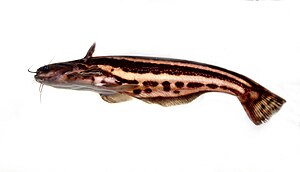False thorn catfish
| False thorn catfish | ||||||||||||
|---|---|---|---|---|---|---|---|---|---|---|---|---|

Trachelyopterichthys taeniatus |
||||||||||||
| Systematics | ||||||||||||
|
||||||||||||
| Scientific name | ||||||||||||
| Auchenipteridae | ||||||||||||
| Bleeker , 1862 |
The false thorn catfish (Auchenipteridae; Gr .: "Alsoen" = neck + "pteryx", - "igos" = fin, because of the dorsal fin located far in front), also called floating thorn catfish , are a family of South American catfish (Siluriformes). Their distribution area includes Brazil , south to Rio de Janeiro , the Guyanas , southern Trinidad , Venezuela , Colombia and eastern Ecuador , Peru , Bolivia and Panama (only Ageneiosus pardalis in the Río Tuira ). All live in fresh water , Pseudauchenipterus nodosus also goes in brackish water .
features
Their body is scaly, the area between the head and the base of the dorsal fin is protected by sculptured bone plates that are located under the skin. False catfish usually have three pairs of relatively short barbels , one on the upper jaw and two on the lower jaw. The pair on the maxillaria is the longest, barbels on the nasals are absent. The dorsal fin stands far forward and is short. The first fin ray of the dorsal fin and the pelvic fins is formed into a powerful spine. An adipose fin is present, but small, but it can also be absent. The anal fin can be long or short. All species are likely to have internal fertilization. For this purpose, in some genera the first two to four rays of the anal fin are transformed into a mating organ. The sideline is often branched or zigzagged.
Way of life
Most species are nocturnal, but some are gregarious and diurnal. Hawthorn catfish feed on crustaceans, worms, insect larvae, small fish, detritus and occasionally on fruits.
External system
Together with the thorn catfish (Doradidae), the false thorn catfish within the catfish-like (Siluriformes) form the superfamily Doradoidea. Sister group of the Doradoidea are the frying pan and Banjowelse (Aspredinidae).
Internal system
There are over 100 species in 20 genera, which are divided into the two subfamilies Auchenipterinae and Centromochlinae . Both subfamilies can be distinguished from one another by the male's reproductive organ. In the subfamily Auchenipterinae, the front part of the anal fin is transformed into a mating organ, the opening of which is normally located at the tip of the first fin ray on the front edge of the anal fin. In the Centromochlinae, the anal fin of sexually mature males is transformed into a seminal, posteriorly directed organ that is parallel to the spine and consists of the fin rays , the enlarged fin supports (radialia) and the long and thickened hemal arches of adjacent vertebrae.
literature
- Günther Sterba : The world's freshwater fish. 2nd Edition. Urania, Leipzig / Jena / Berlin 1990, ISBN 3-332-00109-4 .
- Joseph S. Nelson : Fishes of the World . John Wiley & Sons., 2006, ISBN 0-471-25031-7 .
Individual evidence
- ↑ Ageneiosus pardalis on Fishbase.org (English)
- ↑ Pseudauchenipterus nodosus on Fishbase.org (English)
- ↑ JP Sullivan, Lundberg JG; Hardman M: A phylogenetic analysis of the major groups of catfishes (Teleostei: Siluriformes) using rag1 and rag2 nuclear gene sequences . In: Mol Phylogenet Evol. . 41, No. 3, 2006, pp. 636-62. doi : 10.1016 / j.ympev.2006.05.044 .
- ↑ José LO Birindelli & Jansen Zuanon: Systematics of the Jaguar catfish genus Liosomadoras Fowler, 1940 (Auchenipteridae: Siluriformes) . Neotropical Ichthyology, Volume 10, No. 1, Porto Alegre 2012, doi: 10.1590 / S1679-62252012000100001 , ISSN 1679-6225
Web links
- False thorn catfish on Fishbase.org (English)